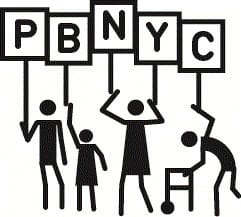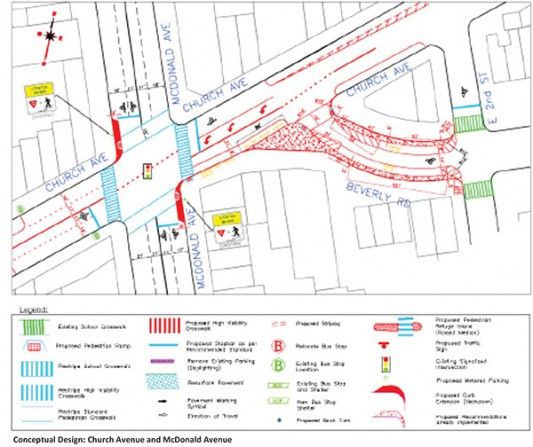Making Public Health and Safety Sexy in Participatory Budgeting


For those proposals that make it to the Participatory Budgeting ballot, it’s hard, even for budget delegates on the Public Health and Safety committee, to get enraptured by the kinds of projects this committee would naturally produce. While the restrictions for this second iteration PBNYC remain — one million dollar absolute maximum, $35,000 minimum project, only capital expenses — filling in holes in the road, adding a stop sign or a traffic signal, or re-doing an intersection isn’t going to, necessarily, capture the pathos of Council District 39 constituents. Beginning on April 2 when the ballot box opens, the Public Health and Safety committee is going to have to work extra hard for their ballot proposals to be “sexy,” for lack of a better term.
Enter Dominic Francese. A newcomer to the process as a delegate but having voted on last year’s ballot, this Carroll Gardens resident spiced up his committee meetings by putting the “tech” into it; and, these days, tech is sexy.
“You need to say this is a big problem, but it’s really hard in this committee. This committee, I think, is a little challenging,” he said.
Facing the challenge, he sedulously compiled the bevy proposals submitted early on by the constituency not as a dry spreadsheet, but as a Google Map.
“Looking at a list of about 60 proposals, it was hard to visualize where all these were and where most people had complaints,” he said.
Check into the map, and one can see what was on their docket via the peppering of blue pips throughout the district. Francese also added icons to indicate traffic reports the committee was given, and he included the descriptions from the spreadsheet of eligible projects.
A thick line spanning Church Avenue shows where the action in Kensington is — a lot of those swanky solar-powered city trash collectors/compactors, naturally.
Marco Castillo, a co-committee member, said about the original selection process, “there were a couple of concerns. We wanted to make sure no part of the district was overlooked.” He had received an invite to Francese’s handiwork via e-mail, and Marco said that the map clarified, “projects at the border.”
While Castillo did mention in January that there was talk of a proposal to improve bicycle and pedestrian safety near Col. Donald Cook Square (and if the moniker doesn’t sound familiar, Cook Square is a NYC Parks and Recreation Greenstreet where Ft. Hamilton, McDonald, and Caton intersect). The proposal was, however, impractical for this year’s ballot in lieu of the kinds of research and traffic studies the DOT would have to conduct prior to committing to roadwork on that scale.
However, the DOT had already identified via the School Safety Engineering Project a two and a half block radius around Yeshiva Torah Temimah School on Ocean Ave between 18th and Ditmas where data shows 737 accidents between 1998-2004, of which five were school-related. The city-wide study classified it as one of the DOT’s 135 priority schools. As such, one of the three proposals the Public Health and Safety Committee is putting forward on the ballot this year is to fund, among other physical design improvements at the nearby sidewalks and intersections, some speed humps.
Another proposal to come out of the committee is right at the heart of Kensington with an extensive restoration of the intersection of Church and McDonald Ave to begin in 2015. The renovation would even include the exhumation of buried trolley tracks.

Okay, a chance to reclaim a bit of history from the asphalt; that could be sexy. But Dominic described in an email their third entry to the ballot:
… a District-wide security camera initiative with one each in Precinct 76 (Hamilton St foot bridge), 72 (Prospect Park Southwest – park entrance), 78 (Prospect Park West – park entrance) and 66 (Church Avenue and McDonald Avenue). We believe this is the first ballot proposal working with the NYPD, so that is exciting.
Add to this Castillo, a professor of public administration and constitutional law at City Tech, who says enthusiastically about the Participatory Budgeting process as a whole: “I think it does activate citizenship … it facilitates people becoming better citizens. With PB you get an active role; you’re immediately given responsibility.”
But while citizens are getting channels to better engage the system, the system is getting in measured doses a taste of this “deliberative democracy.” The Public Health and Safety committee has broken the ice with the NYPD should the vote conclude their project to be one the public finds attractive enough to be awarded PB dollars.
Today all of the proposals to make it to the ballot will be showcased in the Expo at the Park Slope Library, 431 6th Ave from 6:30 to 8:30pm.
Adam Szlachetka, facilitator for the committee, said that the booth housing this landmark proposal will have a laptop set up at the table complete with an interactive component — another Google Map where Expo attendees can add their own input that will at least inform the NYPD on how to proceed when and if this proposal gets selected.
Unearthing a bit of Kensington history … speed humps … a district-wide, multi-precinct induction of yet another city agency into deliberative democracy … all of it wrapped up in a crowd-sourced Google Map … okay, if you can’t call that sexy, at the very least, you can call it cool.




